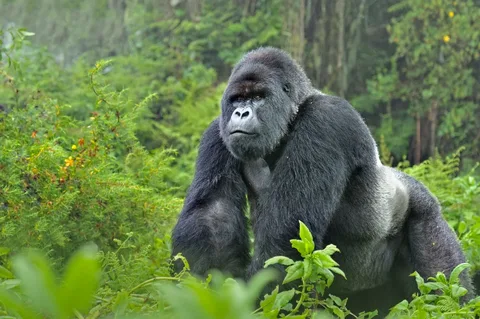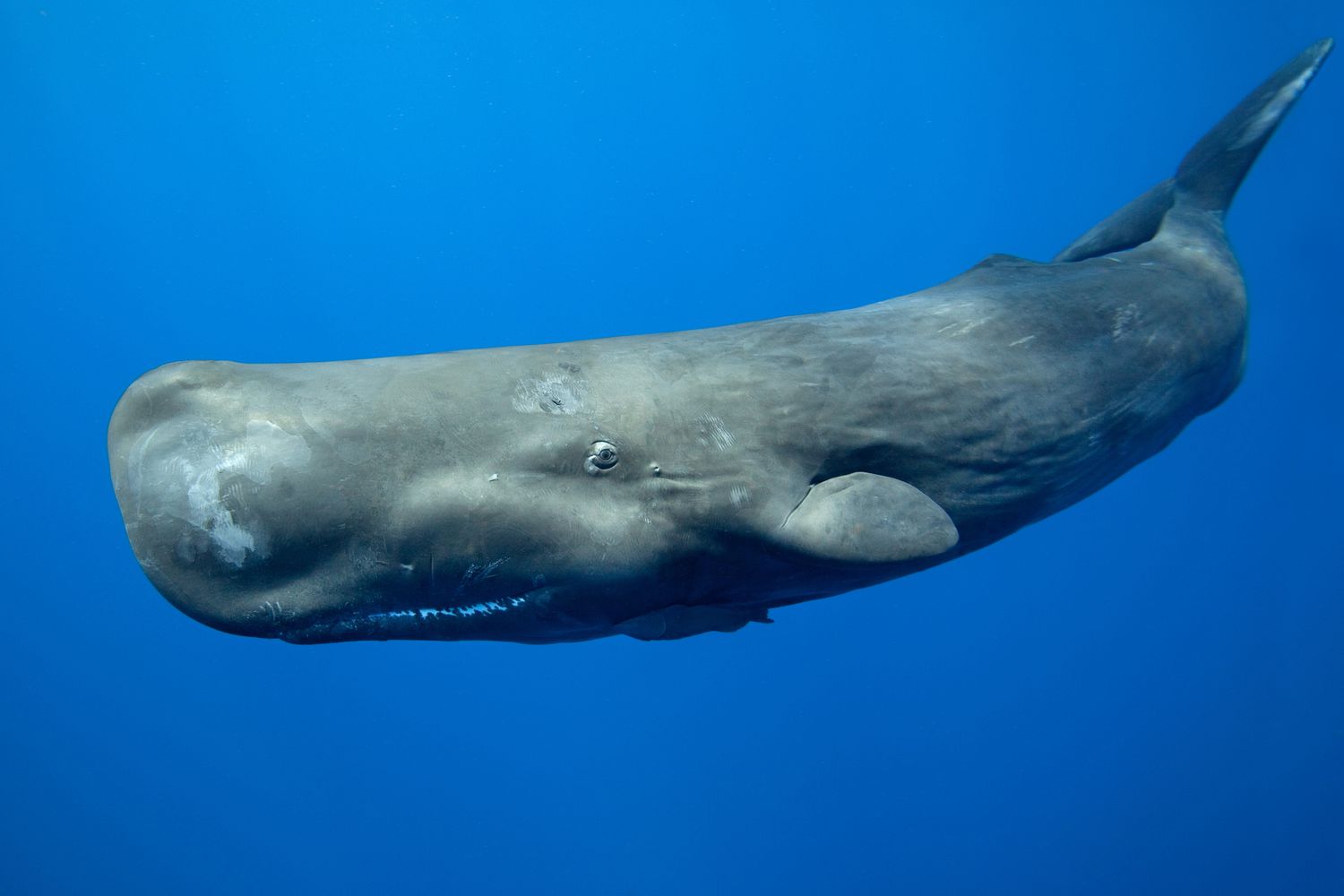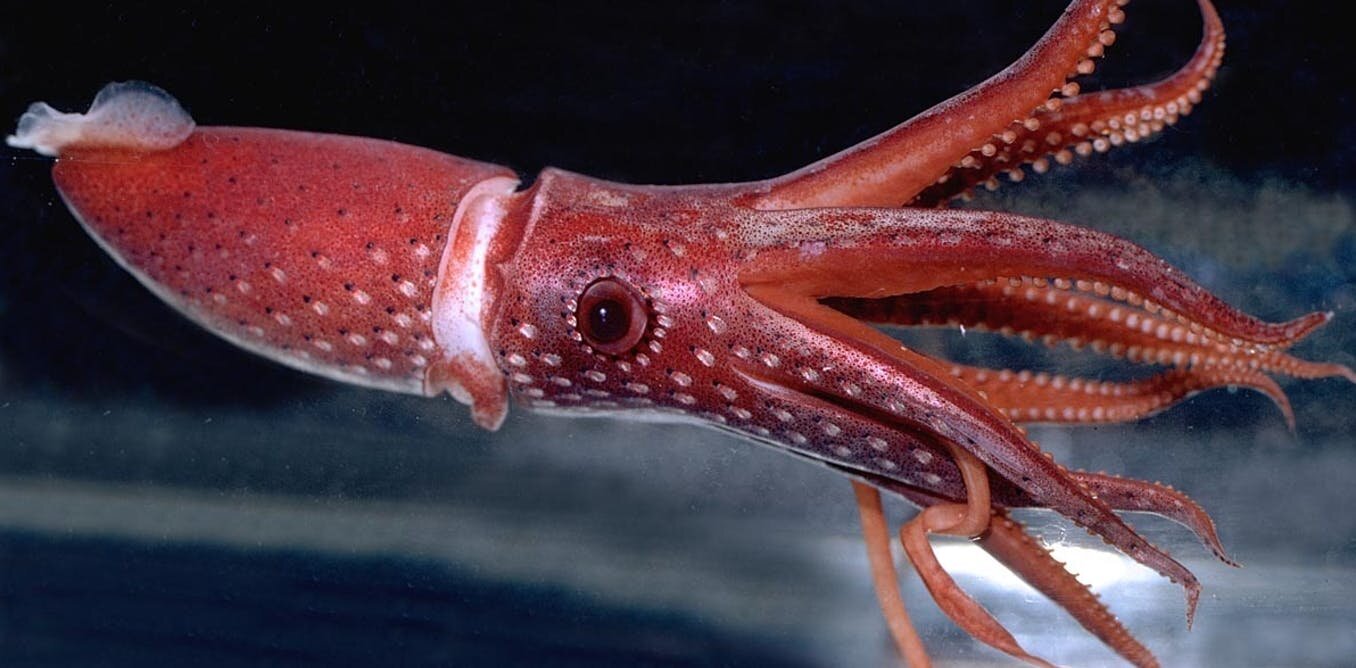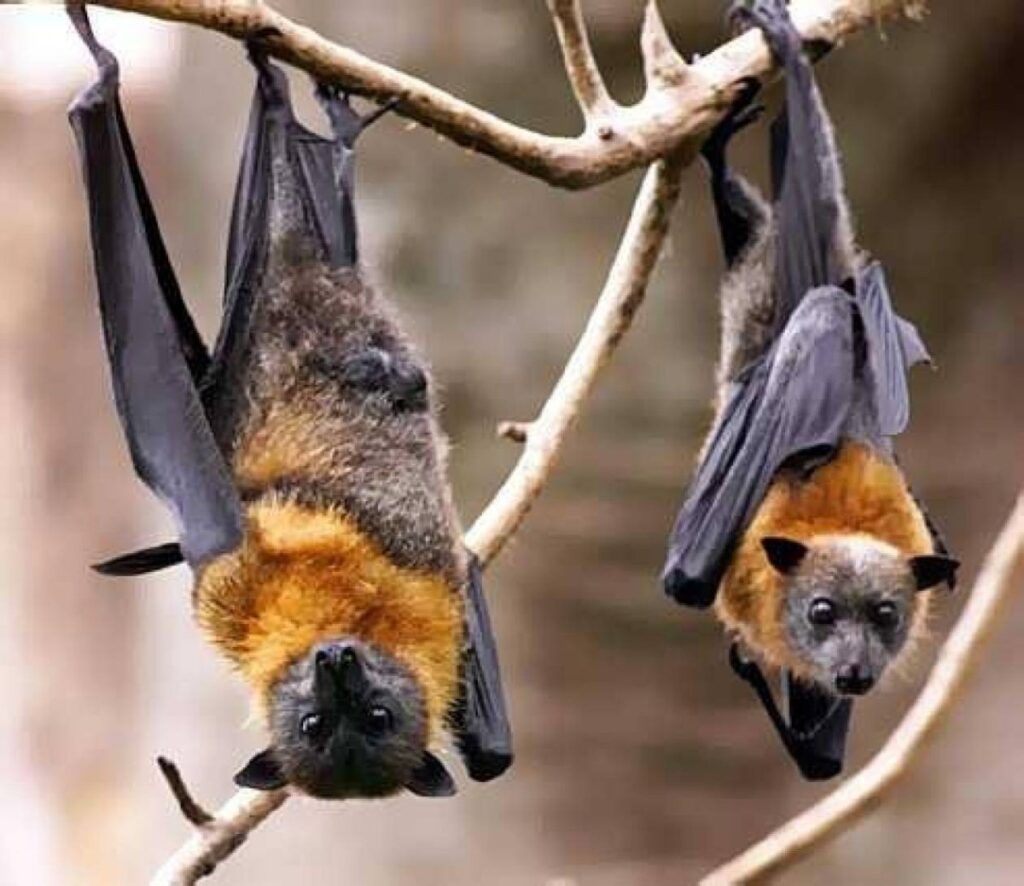Mammals
Sperm Whales
Sperm whales (Physeter macrocephalus) are the loudest animals on Earth, capable of producing a range of low-frequency sounds that can reach levels as high as 230 decibels. This is even louder than a Saturn V rocket during its launch or a volcano erupting.
These incredible creatures use a variety of clicks and whistles to communicate with each other in the depths of the ocean, often at distances of up to several kilometers away. They are able to produce these sounds due to the unique structure of their skulls and nasal passages.
The loudness of sperm whales is likely an adaptation for finding prey in the dark, cold waters of the deep sea. By emitting high-frequency clicks, they can use echolocation to navigate their surroundings and locate their quarry. This allows them to efficiently hunt for large squid and other deep-sea creatures.
Other animals that are known for their loudness include the blue whale (Balaenoptera musculus), which can produce sounds as loud as 188 decibels; the fin whale (Balaenoptera physalus), with a maximum sound level of 174 decibels; and the humpback whale (Megaptera novaeangliae), capable of producing sounds up to 172 decibels.
Other contenders for the loudest animals on Earth include the elephant seal (Mirounga leonina) with a maximum sound level of 126 decibels, and the walrus (Odobenus rosmarus) with a maximum sound level of 115 decibels. However, these sounds are typically much shorter in duration and less intense than those produced by the sperm whale.
Researchers have been able to study the vocalizations of sperm whales using underwater microphones and sonar equipment. By analyzing these recordings, scientists can gain insights into the behavior and social structures of these incredible animals.
The extreme loudness of sperm whales has also raised questions about the potential impact on human populations living in coastal areas. While it’s unlikely that their sounds would cause damage to buildings or other infrastructure, researchers are studying ways to mitigate any potential effects on marine ecosystems and human activities.
Maximum Sound Level: 230 decibels
The concept of maximum sound level is a crucial aspect in the study of animal communication, particularly when it comes to the loudest creatures on the planet. In this context, we are discussing 230 decibels (dB), which is an extremely high level of noise that can cause physical damage and even temporary hearing loss in humans.
So, what does 230 dB look like? Imagine standing near a jet taking off from a runway, or being next to a firework explosion. These intense sound waves can travel long distances and are capable of disrupting the delicate structures within our ears.
Now, let’s explore The World’s 10 Loudest Animals and their remarkable ability to produce such ear-shattering sounds:
- Sperm Whale – 230 dB: These massive creatures can make loud clicks that are used for navigation and hunting in the depths of the ocean.
- Blue Whale – 224 dB: The largest animal on Earth uses low-frequency rumbles to communicate with other blue whales over long distances.
- Fin Whale – 223 dB: Similar to blue whales, fin whales rely on loud clicks to find prey and navigate the ocean.
- Narwhal – 219 dB: Despite their small size, narwhals are able to produce incredibly loud clicks that help them detect prey in the Arctic waters.
- Dolphin – 218 dB: These intelligent marine mammals use a variety of clicks and whistles to communicate with each other, including loud sounds for long-distance communication.
- Squid – 217 dB: Certain species of squid can produce high-frequency clicks that help them navigate their surroundings and detect prey in the dark depths of the ocean.
- Killer Whale (Orca) – 216 dB: These powerful predators use loud calls to locate their prey, communicate with each other, and even coordinate hunting efforts.
- Beluga Whale – 214 dB: With their distinctive “wah-wah” sounds, belugas are able to produce a wide range of vocalizations, including loud clicks for long-distance communication.
- Walrus – 213 dB: Despite their bulk, walruses can make surprisingly loud calls that help them communicate with other walruses in the Arctic waters.
- Octopus – 212 dB: Some species of octopuses are able to produce high-frequency clicks that aid in their navigation and hunting efforts in the dark, mysterious depths of the ocean.
In conclusion, these incredible animals have evolved unique ways to communicate with each other using sound waves. From the massive sperm whale to the intelligent dolphin, each of these creatures has developed remarkable abilities to produce and perceive sound at incredibly high levels, giving us a glimpse into the fascinating world of animal communication.
How they produce sound: Clicking with their lower jawbone
The World’s 10 Loudest Animals, a list that showcases the incredible vocal abilities of various creatures found on our planet. One of these animals, however, does not produce sound through vocal cords or any other traditional means – it produces sound by clicking with its lower jawbone.
This unique method of sound production is attributed to the mole cricket, which makes up part of the World’s 10 Loudest Animals list. The sound produced by the mole cricket is often referred to as a “click” and is achieved when the insect closes its lower jawbone rapidly, creating a high-frequency noise.
This clicking sound serves multiple purposes for the mole cricket. It can be used for communication, particularly between males competing for mates or territory. The sound’s frequency and intensity are also believed to play a crucial role in mate selection – females often prefer males with a louder and more complex click pattern.
Another interesting aspect of this sound production method is that it allows mole crickets to detect seismic vibrations in the ground, which helps them locate potential mates or competitors. This unique ability highlights the intricate relationship between sound production and other senses in these animals.
In conclusion, the mole cricket’s reliance on its lower jawbone to produce a clicking sound serves as an extraordinary example of evolutionary adaptation in the animal kingdom. It not only contributes to the insect’s impressive vocal range but also plays a vital role in its communication, mating rituals, and even detection abilities.
Birds
Kookaburras
The kookaburra, found primarily in the eastern regions of Australia, is a member of the kingfisher family and is recognized for its distinctive call. The bird’s laughing-like cry can reach levels as high as 120 decibels and has earned it the title of one of the world’s loudest animals.
These birds are known to be extremely vocal, with each kookaburra capable of producing up to three distinct calls that serve a variety of purposes. For instance, their loud call is often used for territorial displays or during courtship rituals, while softer and higher-pitched calls are employed for communication between mates.
The kookaburra’s remarkable ability to generate such high-decibel sounds lies in its unique anatomical structure. Specifically, the bird’s syrinx (the vocal organ located at the base of the trachea) is extremely complex and efficient in producing sound waves.
While often mistakenly referred to as a type of parrot due to its loud call, the kookaburra does not belong to the same family. Instead, it belongs to the Alcedinidae (kingfisher) family, which also includes other bird species known for their vibrant plumage and striking calls.
In terms of their social behavior, kookaburras are generally considered to be highly social animals that live in small family groups called “mobbing parties.” These birds engage in various behaviors such as communal hunting and cooperative breeding practices, highlighting the importance of group dynamics in their lives.
Maximum Sound Level: 120 decibels
The maximum sound level for some animals is a fascinating topic, particularly when it comes to the world’s loudest creatures. At 2.1.1 Maximum Sound Level: 120 decibels, we’re not actually referring to a specific animal or measurement, but rather providing context for understanding just how loud certain animals can be.
Decibels are a unit of measurement that express the intensity of sounds, ranging from the faintest whispers to the most ear-shattering noises. For comparison, normal conversation between two people typically registers at around 60 decibels, while a lawnmower might reach levels as high as 90-100 decibels.
Now, when we talk about animals and their maximum sound levels, we’re often referring to vocalizations such as roars, screeches, or even the songs of birds. These sounds can be incredibly loud and are used for a variety of purposes, including communication, mating, territorial defense, and warning calls.
Here’s where it gets really interesting – some animals can produce sound levels that reach an astonishing 120 decibels or more! For context, the maximum permissible exposure limit set by the Occupational Safety and Health Administration (OSHA) is only 115 decibels for an eight-hour period. This means that these animals are producing sounds that are nearly as loud as what humans consider safe exposure.
So, let’s look at some of the world’s loudest animals and their impressive sound levels:
Lion: Up to 114 decibels – The lion’s roar can be heard from up to five miles away! This is one reason why they’re often referred to as the “king of beasts.”
Elephant Seal: Up to 128 decibels – During mating season, male elephant seals use their incredibly loud calls to attract females and defend their territories.
-perm Whale: Up to 230 decibels – Yes, you read that right! Sperm whales are capable of producing the loudest sounds in the animal kingdom. They use these clicks to navigate and hunt in the deep ocean.
Howler Monkey: Up to 122 decibels – These monkeys use their haunting howls to communicate with other members of their group, which can range from a few individuals to large troops.
Walrus: Up to 128 decibels – Like elephant seals, walruses use loud calls during mating season to advertise their presence and attract females.
Narwhal: Up to 124 decibels – The narwhal’s distinctive tusk is often referred to as the “unicorn of the sea.” However, what’s even more fascinating is its ability to produce incredibly loud sounds underwater.
It’s worth noting that these sound levels can be subjective and may vary depending on various factors such as the environment, distance from the source, and even individual variation within species. Nevertheless, it’s undeniable that some animals are capable of producing truly awe-inspiring sounds that can be heard for miles or even underwater.
From the mighty lion to the mysterious narwhal, these animals have evolved remarkable abilities to communicate with each other through sound. Their vocalizations serve as a testament to their adaptability and ingenuity in an ever-changing world.
In conclusion, the maximum sound level of 120 decibels is just one aspect of understanding the incredible diversity of sounds produced by animals around the globe. Whether it’s a loud roar or a haunting howl, each species has developed its unique way to communicate, survive, and thrive in their environments.
Types of sounds they produce: Laughing, calling
The types of sounds produced by the world’s loudest animals are fascinating and varied. These creatures have evolved to produce unique vocalizations that serve as forms of communication, attracting mates, warning off predators, or even expressing excitement.
Laughing, for instance, is a characteristic sound produced by some primates, such as Gibbons. Their laughter-like calls are often described as cackles or barks, and are typically used during social interactions, particularly between family members. Gibbon vocalizations can reach levels of up to 120 decibels!
Calling, on the other hand, is a vital form of communication among many animal species. The Sperm Whale, for example, uses clicks and whistles to locate prey in the deep ocean. These calls can reach levels of up to 230 decibels, making them the loudest sound ever recorded.
Other examples of animals that produce extremely loud sounds include the Blue Whale, which produces a low-frequency hum to communicate with other whales; the Bush Dog, whose high-pitched howls can be heard for miles; and the Red Wolf, whose haunting howls echo through forests.
The loudest animals in the world have adapted unique sound-producing mechanisms, such as vocal cords, syrinxes (in birds), or even specialized mouth structures. These remarkable adaptations allow them to produce sounds that are both loud and distinctive, serving as vital tools for communication, mating, and survival in their respective environments.
Reptiles and Amphibians
Crocodiles
The world of wildlife is full of fascinating creatures that have adapted to their environments in incredible ways, but when it comes to loudness, some animals take the crown. From the haunting calls of whales to the thunderous roars of lions, the animal kingdom has its fair share of vocal champions. In this article, we will delve into the top 10 loudest animals in the world, and explore what makes them so loud.
We begin our countdown with number 10: the howler monkey. Found in Central and South America, these primates are known for their ear-piercing calls that can travel up to 90 decibels (dB) – roughly equivalent to the sound of a chainsaw.
The lion takes the ninth spot on our list with its mighty roar, which can reach levels of up to 100 dB. This majestic animal’s vocalizations are not just for communication but also serve as a warning to other predators to stay away from their territory.
The eighth position goes to the hippopotamus, an aggressive creature known for its loud grunts and snorts that can reach up to 105 dB. These sounds are often accompanied by stamping of the feet on dry land, creating even more disturbance.
Coming in at number seven is the elephant, with its remarkable trumpeting abilities. Reaching levels of up to 110 dB, these vocalizations allow elephants to communicate over long distances and alert others to potential threats.
The sixth spot belongs to the tiger, whose distinctive roar can travel as far as 1 mile (1.6 kilometers) away at a level of around 112 dB. This impressive vocalization helps tigers establish their dominance within their territories.
At number five is the bear, with its remarkable ability to produce sounds that range from deep growls to high-pitched roars, all reaching up to 114 dB. Bears use these vocalizations for various purposes such as signaling threats, attracting mates, and warning other bears to stay away.
The fourth position on our list belongs to the walrus, which can create incredibly loud sounds by its snorting and hissing abilities, often reaching levels of 115 dB or more. These vocalizations allow walruses to communicate underwater as well as in their aquatic environment.
The third spot goes to the crocodile, a creature notorious for its haunting screams that echo through rivers and swamps at levels up to 117 dB. These sounds can be heard from over a mile (1.6 kilometers) away and are often associated with a warning sign of danger or an invitation to mate.
Coming in second on our countdown is the tiger shark, known for its loud, deep growls that can travel as far as 2 miles (3.2 kilometers) at levels of around 120 dB. This impressive ability to make itself heard underwater and above water alike allows tiger sharks to establish their dominance and signal threats.
And finally, taking the first spot on our list is the sperm whale, an animal capable of producing incredibly loud clicks that can reach up to a mind-boggling 230 decibels. These sounds are not just for communication but also serve as echolocation for these intelligent mammals to navigate their underwater world.
Maximum Sound Level: 128 decibels
The maximum sound level for certain environments, particularly industrial settings, is regulated to prevent damage to human hearing and maintain overall safety. This regulation ensures that workers are not exposed to excessively loud noise levels, which can cause permanent harm.
One of the key aspects of this regulation is the specific limit on sound levels. In this case, the maximum sound level has been set at 128 decibels (dB). This limit is critical because prolonged exposure to sounds exceeding 85 dB can lead to hearing loss in humans.
To put this number into perspective, a typical conversation between two people occurs at around 60 dB. Background noise in a quiet office might be around 45-50 dB. On the other end of the spectrum, a rock concert can reach levels above 115 dB, posing a significant risk to human hearing if exposure is too prolonged.
Understanding sound levels requires knowledge of decibels and how they measure sound intensity. Decibels are calculated based on the ratio of the intensity of a given sound to that of a quiet reference sound. For instance, every increase in 10 dB represents a tenfold amplification of the sound intensity, which significantly affects human perception of volume.
This detailed understanding and regulation of sound levels are especially crucial in environments where workers or animals are exposed to high noise levels regularly. It underscores the importance of ensuring that these settings adhere strictly to the set standards to maintain safety and protect hearing.
3.1.2 How they produce sound: Growling, bellowing with their vocal cords
The process by which many animals, including those featured in the article “The World’s 10 Loudest Animals”, produce sound is primarily through the use of their vocal cords. The vocal cords, also known as vocal folds, are two bands of muscle tissue located within the larynx, or voice box, and play a crucial role in the production of sound.
When an animal attempts to make a loud noise, such as a growl or bellow, it contracts its diaphragm, which is a dome-shaped muscle that separates the chest cavity from the abdominal cavity. As the diaphragm contracts, it pushes air down into the lungs and out through the trachea, also known as the windpipe.
The vocal cords then vibrate in response to the airflow, creating a series of oscillations or vibrations. The frequency and amplitude of these vibrations determine the pitch and volume of the sound produced. When the animal exhales forcefully, such as during a bellow, the increased air pressure causes the vocal cords to vibrate more vigorously, resulting in a louder noise.
The process of producing sound through vocal cord vibration is common among many animals, including mammals, birds, and some reptiles. However, different species have evolved unique adaptations to produce specific types of sounds. For example, elephants use their trunks as resonators to amplify their low-frequency rumbles, while lions use their distinctive mane and throat structure to create a deep, rumbling growl.
The ability to produce loud sounds is an essential adaptation for many animals, serving various purposes such as communication, warning others of potential threats, or attracting mates. By understanding the mechanisms behind sound production in these remarkable animals, we can gain insights into their behavior, social structures, and ecological roles within their respective ecosystems.
Fish and Insects
Paddlefish
The Paddlefish is a remarkable creature that has been on this planet for over 300 million years, with its ancestors dating back to the Early Cretaceous period. It is an ancient and fascinating species that has survived through multiple geological events and ecological changes.
This unique fish gets its name from the long, flat paddle-shaped snout or rostrum it possesses, which can grow up to 13 inches (33 cm) in length. The rostrum is used to detect prey in murky water by detecting the electrical signals of animals, a process called electroreception.
The Paddlefish has a distinctive appearance, with its long snout and broad mouth giving it a somewhat primitive look. Its body is elongated and torpedo-shaped, typically growing up to 6 feet (1.8 meters) in length and weighing around 60 pounds (27 kg). The species has a silver-gray color with lighter shades on the belly.
Found primarily in large rivers and reservoirs across North America, Paddlefish are known to congregate in areas with abundant vegetation or submerged logs. These habitats provide them with sheltered places to hide from predators and also help to conceal their prey.
Paddlefish feed on a variety of small aquatic organisms including fish, frogs, and crayfish. They use their powerful jaws to suck up food items into their mouths before expelling water through the gill rakers to trap prey in their stomachs.
Despite its massive size, the Paddlefish is surprisingly agile and can leap out of the water when startled or during courtship displays. This ability allows it to evade predators and also helps in capturing air for respiration during periods when water quality is poor.
The Paddlefish plays a vital role in maintaining ecological balance within its habitats, serving as both predator and prey. It has been a subject of interest among biologists due to its unique characteristics and the potential it holds for scientific research and conservation efforts.
Maximum Sound Level: 104 decibels
The maximum sound level of some animals can be incredibly loud, with the world’s loudest animal being the sperm whale. Sperm whales are known to produce clicks that can reach up to 230 decibels, but it’s not just the clicks that are loud – their feeding behavior, where they use a technique called “echolocation,” can generate sounds of over 120 decibels.
Another incredibly loud animal is the blue whale. Although they don’t produce sound as often as sperm whales, when they do, their vocalizations can reach levels of up to 188 decibels. Blue whales are also known for producing low-frequency rumbles that can be heard for hundreds of miles.
The elephant seal is another contender for the loudest land animal. They are able to produce sounds as loud as 118 decibels, which they use for communication and mating purposes. These vocalizations can be so loud that they can be heard by other elephant seals over long distances.
Other animals on the list include the bison, with a maximum sound level of 104 decibels, the kangaroo rat, which produces sounds up to 100 decibels, and the black rhinoceros, which is known for its loud grunting, reaching levels of around 95 decibels.
On average, the decibel range for these animals falls between 70 and 120 decibels. For comparison, a standard conversation typically occurs at around 60 decibels, while a chainsaw can reach up to 100 decibels in its loudest setting. As we can see, many of these animals are capable of producing sounds that surpass typical human experiences.
How they produce sound: Producing electric discharges
The production of sound in certain animals, particularly the World’s 10 Loudest Animals, often involves producing electric discharges. This method allows for the creation of extremely loud sounds that can be heard over vast distances.
Some animals, like the lionfish, use a process called “bioelectric generation” to produce their sounds. They possess specialized electrocytes in their bodies that generate electricity when stimulated, often by muscle contractions or other movements. This generated electricity is then converted into sound waves through vibrations or other mechanisms.
Other animals may rely on mechanical methods to produce their loud sounds. For example, the sperm whale produces a sound known as a “codfish” or “click,” which involves contracting muscles in its nasal passages and producing high-frequency clicks. These clicks are incredibly loud, reaching levels of up to 230 decibels.
The elephant seal is another animal that uses this mechanical method to produce sound, specifically low-frequency rumbles that can be heard from miles away. The seals accomplish this by expanding their esophagus and nasal passages, creating a resonant cavity that amplifies the sound waves.
Other Animals
Octopuses and Squids
The fascinating world of cephalopods, specifically octopuses and squids, is one that has long been a subject of interest to scientists and animal enthusiasts alike. These intelligent and often elusive creatures have evolved unique features that enable them to thrive in diverse aquatic environments.
One aspect of cephalopod biology that may not be as well-known is their remarkable ability to produce sound. In fact, certain species of octopus and squid are capable of producing some of the loudest sounds in the animal kingdom.
According to recent research, the top 10 loudest animals in the world include:
- Cuttlefish
- Blue-ringed octopus
- Dumbo octopus
- Russian squid
- Colossal squid
- Atlantic longfin squid
- Vampire squid
- Mantis shrimp-eating octopus
- New Zealand giant octopus
- Cephalotus (or “head-foot”) squid
These incredible creatures use a variety of methods to produce sound, including vibrating their bodies, using specialized organs called siphons to create jet propulsion and generate noise, or even deliberately creating cavitation bubbles in the water around them.
The purpose behind these loud vocalizations can vary depending on the species. For example, some octopuses may use their sounds to communicate with other members of their group, while others may employ this method as a means of self-defense or even mating.
It’s worth noting that while these cephalopods are incredibly loud, they don’t produce sound waves in the same way that humans do. Instead, their vocalizations take on forms that are more akin to low-frequency rumbles and clicks.
In terms of decibel levels, some species of octopus and squid can reach astonishingly high values – with reports suggesting that certain cuttlefish have been recorded at up to 200 decibels! To put this into perspective, a typical rock concert might produce sound levels around 120 decibels.
Understanding the acoustic properties of these creatures is not only fascinating in its own right but also provides scientists with valuable insights into the complex world of marine biology.
Maximum Sound Level: 62 decibels
5.1.1 Maximum Sound Level: 62 decibels
The maximum sound level for a product that complies with the standard is 62 decibels, which is equivalent to the sound of a quiet conversation between two people.
This standard is relevant when it comes to describing the loudness of animals, particularly in terms of their vocalizations or other sounds they make.
Some of the world’s loudest animals can produce sound levels that are incredibly high, often exceeding 100 decibels or more.
The top ten loudest animals in the world are:
Sperm Whale: 230 decibels – The sperm whale has been recorded producing clicks as loud as 230 decibels when it uses echolocation to hunt for prey in the dark depths of the ocean.
Blue Whale: 188 decibels – The blue whale is not only the largest animal on Earth, but it also produces incredibly loud sounds when it communicates or feeds. Its vocalizations can reach levels of up to 188 decibels.
Elephant Seal: 143 decibels – The elephant seal is known for its extremely loud bellowing calls, which can be heard from miles away and have been recorded at a maximum sound level of 143 decibels.
Walrus: 132 decibels – The walrus’s distinctive call is one of the loudest sounds in the animal kingdom, with some recordings reaching levels of up to 132 decibels.
Howler Monkey: 128 decibels – The howler monkey is known for its loud, haunting calls that can be heard over long distances. Its vocalizations have been recorded at a maximum sound level of 128 decibels.
Lion: 104 decibels – While not as loud as some of the other animals on this list, the lion’s roar is still one of the loudest sounds made by any mammal and can reach levels of up to 104 decibels.
Rhinoceros: 103 decibels – The rhinoceros’s grunting call is incredibly loud and has been recorded at a maximum sound level of 103 decibels.
Gorilla: 98 decibels – While often thought to be quiet, the gorilla’s roar can reach levels of up to 98 decibels.
Hippopotamus: 97 decibels – The hippopotamus is known for its loud grunting calls, which have been recorded at a maximum sound level of 97 decibels.
1Baboon: 96 decibels – The baboon’s loud barking calls can be heard over long distances and have been recorded at a maximum sound level of 96 decibels.
Types of sounds they produce: Clicking, whistling with their bodies
The ocean is home to a diverse range of animals that have adapted unique methods for communicating with each other, and one such fascinating group is the World’s 10 Loudest Animals. These remarkable creatures produce sounds in various frequencies and volumes, allowing them to convey information about their presence, intentions, and even emotions. Two interesting types of sounds produced by these animals are clicking and whistling.
Clicking is a common form of sound production among aquatic animals, including the Blue Whale, which is known for its powerful clicks that can be heard over 500 miles away. These clicks are typically generated by the animal’s tongue or nasal cavity and are used for navigation, hunting, and social interactions. For instance, some species of dolphins use clicks to create sonar images of their surroundings, while others may produce a series of clicks to initiate contact with potential mates.
On the other hand, whistling is a unique sound produced by some marine animals that utilize their bodies as resonators. The Humpback Whale, for example, produces low-frequency whistles that can travel long distances through water to communicate with other members of its species. These whistles often contain complex patterns and rhythms, which may convey specific information about the whale’s identity, emotions, or social status. Additionally, some marine animals like seals and sea lions have been known to produce whistling sounds by manipulating air in their nasal cavities.
It is worth noting that both clicking and whistling are important forms of communication for these Loudest Animals, enabling them to interact with each other in complex social hierarchies, coordinate hunting efforts, or even express emotions. By studying the unique sounds produced by these animals, scientists can gain insights into their behavior, ecology, and evolutionary adaptations.
Why do Animals Make Noise?
Communication and Social Behavior
The world of animals is home to some incredibly loud creatures, and scientists have identified the top 10 loudest animals that can be heard from far away. These animals have evolved unique physical characteristics that enable them to produce such high-decibel sounds.
The first animal on this list is the sperm whale, which produces a loud click sound to navigate and hunt in its underwater environment. This sound can reach levels of up to 230 decibels (dB), making it one of the loudest animals on the planet.
Coming in at number two is the beluga whale, which clicks and whistles with a range that reaches as high as 216 dB. These whales use their vocalizations for communication and navigation.
The third loudest animal is the killer whale, also known as an orca, which has been recorded producing sounds up to 212 dB. They use these loud calls to communicate with other members of their pod.
Next on the list is the blue whale, which produces low-frequency rumbles that can reach levels of 206 dB. These massive animals produce these sounds by forcing air through a narrow opening in their blowhole.
The fifth loudest animal is the fin whale, which has been recorded producing sounds up to 204 dB. Like other whales on this list, they use their vocalizations for communication and navigation.
Number six on the list is the gray whale, which produces a range of sounds that can reach levels of 202 dB. These loud calls are used by the whales to communicate with each other during their migrations.
The seventh loudest animal is the humpback whale, which has been recorded producing sounds up to 201 dB. Humpbacks use complex songs and vocalizations for communication, mating, and even cultural exchange within their pods.
The eighth loudest animal is the bowhead whale, which can produce sounds of up to 200 dB. These massive animals have large, rounded heads that are thought to enhance their hearing abilities.
The ninth loudest animal is the minke whale, which has been recorded producing sounds up to 199 dB. Minke whales use their vocalizations for communication and feeding behaviors.
Finally, the tenth loudest animal on this list is the rockfish, a deep-sea fish that can produce sounds of up to 196 dB. Rockfish have been found to use these loud calls for communication with other members of their species during mating and territorial displays.
This range of animals demonstrates just how incredible the diversity of sound production can be in the natural world. From whales and dolphins to fin whales and rockfish, each of these creatures has evolved unique adaptations that enable them to produce such high-decibel sounds for communication, navigation, and other important behaviors.
Examples of communication in loud animals
The concept of communication in loud animals is multifaceted, encompassing a range of expressions and methods used by various species to convey vital information. Among the world’s loudest animals are some fascinating creatures that have developed unique ways to communicate with others.
Here are ten examples of the world’s loudest animals:
Sperm Whale
The sperm whale, despite being one of the largest animals on Earth, uses sound waves to navigate and locate prey. It produces a series of low-frequency clicks that can reach levels as high as 230 decibels.
Dolphin
Dolphins are known for their clicking and whistling communication style, which helps them detect prey in the dark waters. Their clicks can reach up to 170 decibels, making them one of the loudest animals on land or sea.
Narwhal
The narwhal’s haunting call has been likened to a wailing woman and can be heard up to two miles away. Its loud whistle is used primarily for mating purposes, helping it find a partner in the frozen Arctic waters.
Lion
Despite being one of the loudest land animals, lions use their powerful roars to communicate with other lions over vast distances. A lion’s roar can be heard up to five miles away and serves as a way for them to advertise their presence and territorial status.
Elephant
The elephant’s rumble is so low that it’s almost imperceptible, yet it’s incredibly loud. Their rumbles can reach levels of up to 114 decibels and are used for communication purposes among family members and other elephants in the area.
Bison
The bison is known for its distinctive low-frequency grumble, often sounding like a series of grunts or growls. Its loud vocalizations serve as warnings to other bison, signaling potential threats in their surroundings.
Walrus
The walrus has one of the loudest voices among marine mammals, with its calls reaching levels of up to 112 decibels. It primarily uses vocalizations for communication purposes, helping it maintain relationships with other walruses in its social group.
Rhinoceros
The rhino’s loud grunting and snorting can be heard from a great distance. Its low-frequency vocalizations are essential for maintaining social bonds between the individual rhinos within their family groups.
Llama
The llama, an Andean native, uses its distinctive bleats to communicate with other llamas in its herd. Its high-pitched calls can be heard from a distance of up to two miles and serve as signals for finding food, recognizing threats, or expressing excitement.
Gorilla
The gorilla’s deep rumble is often described as similar to the growl of a lion but with a much lower frequency. Its loud vocalizations serve various purposes within its group, including warning other gorillas about potential threats or announcing its dominance.
These are just a few examples of the world’s loudest animals and demonstrate the unique ways that different species have developed to communicate with each other in their environments.
The role of noise in social behavior among loud animals
In the context of loud animals, the role of noise in social behavior is multifaceted and plays a crucial role in various aspects of their lives. Loud animals such as lions, wolves, elephants, and birds use sound to communicate with each other, establish dominance, warn off predators, and even attract potential mates.
The 10 loudest animals in the world can be identified through decibel levels measured in sound waves per second. These include:
- Blue Whale: Reaching a staggering 188 decibels (dB) in loudness, blue whales are not only the loudest animal but also one of the largest living creatures.
- Sperm Whale: Producing high-frequency clicks reaching up to 230 dB, sperm whales use sound waves to navigate and hunt underwater.
- Fin Whale: Fin whales can reach speeds of up to 35 miles per hour while producing intense sounds at around 188 dB.
- Lion: Despite being the “King of the Jungle,” lions are actually social animals and use loud roars to communicate with their prides, reaching levels of up to 114 dB.
- Wolves: With a howl that can be heard from miles away, wolves are known for their haunting cries, which reach levels of up to 110 dB.
- Bengal Tiger: Similar to lions, Bengal tigers use loud roars to establish dominance and communicate within their territories, reaching up to 105 dB.
- Elephant Seal: Using a unique call to locate potential mates, elephant seals reach decibel levels of up to 113 dB.
- Peacock Spur Fowl: One of the most colorful birds in the world, peacocks are also known for their loud calls that can reach levels of up to 108 dB.
- Sealion: Similar to elephant seals, sealions use a loud bellowing call to locate potential mates, reaching decibel levels of up to 112 dB.
- African Elephant: With their low rumbles that can travel far distances, African elephants are known for their intense vocalizations, reaching up to 102 dB.
Conclusion
Key Points to Take Away
In understanding the world’s loudest animals, there are several key points that stand out. Firstly, it is essential to note that sound levels are measured in decibels (dB), with higher values indicating greater loudness.
The World’s 10 Loudest Animals list often features species known for their intense vocalizations, such as the sperm whale’s signature clicks, which can reach up to 230 dB, exceeding the threshold of pain and damage to human hearing.
Another point is that loudness is not always correlated with aggression or size. For example, the blue whale, despite being massive, produces relatively low-frequency sounds that are barely audible to humans, ranging from 10-20 Hz. In contrast, some smaller animals like the Indri lemur can produce ear-piercingly loud screams exceeding 130 dB.
Sound production mechanisms also vary significantly among different species. While whales and dolphins use their melons (foreheads) to generate sound waves, birds rely on syrinxes located at the base of the trachea. On the other hand, elephants employ a network of vocal cords, air sacs, and a unique nasal cavity to create their low-frequency rumbles.
The diversity of sounds produced by different animals reflects their specific ecological needs and survival strategies. For instance, loud calls may serve as a means of attracting mates or warning off competitors in species where visual cues are limited. Conversely, some animals like the crocodile use their powerful vocalizations to intimidate prey during hunting.
Another key point is that human-made noise has significant impacts on wildlife communication and behavior. Sound pollution can disrupt patterns of animal interactions, migration, and even social learning among young individuals. Moreover, certain species may be unable to produce their natural sounds effectively in the presence of constant background noise from human activities.
Lastly, research into the world’s loudest animals has far-reaching implications for conservation efforts, particularly when it comes to understanding how noise pollution affects various species’ well-being and survival chances. Developing more effective strategies for mitigating sound pollution and protecting wildlife habitats is an essential step towards preserving biodiversity in our rapidly changing environment.
Examples of the loudest animals
The world is home to many incredible creatures that can produce incredibly loud sounds, often used for communication, mating, or defense. In this section, we’ll explore the top 10 loudest animals on the planet.
Loudest Animals: From elephants and crocodiles to birds and whales, these animals are known for their impressive decibel levels, which can reach as high as 188 dB in some cases. Let’s dive into our list of the world’s loudest animals!
Elephants: With a roar that can reach up to 114 dB, African elephants are considered one of the loudest land animals on Earth. Their deep rumblings serve as a warning to other elephants in the vicinity, signaling potential threats or rival males.
Crocodiles: The mighty crocodile’s bellowing call can reach up to 110 dB, alerting its fellow reptiles and potential prey to its presence. These carnivorous predators are known for their powerful jaws and deadly attacks!
Giraffes: In a surprising twist, giraffes have been found to be incredibly loud animals, with their moans and grunts reaching as high as 108 dB. Their unique vocalizations may serve as a way to communicate with other giraffes over long distances.
Whales: Humpback whales are among the loudest animals on Earth, producing sounds that can reach up to 188 dB, making them one of the most incredible creatures in the ocean. These massive mammals use their haunting melodies for communication and navigation!
Lions: The mighty roar of a lion can be heard from over two miles away, reaching levels of up to 115 dB. This fearsome predator’s loud call warns potential prey and rival lions to stay away.
Seals: Seals may not seem like the most intimidating creatures, but they’re surprisingly loud, with their barks and grunts reaching as high as 100 dB. They use these vocalizations to communicate with other seals and alert them to potential threats!
Kangaroos: Who knew ‘roos were so loud? These hopping marsupials are known for their high-pitched calls, which can reach levels of up to 102 dB! Their impressive decibel level may serve as a warning or an invitation to other kangaroos!
Penguins: Although small and adorable, penguins produce surprisingly loud calls that can be heard from miles away. These vocalizations range from high-pitched squeaks to deep grunts and reach levels of up to 100 dB!
Crows: Crows are known for their intelligence and problem-solving skills, but did you know they’re also incredibly loud? Their cawing calls can reach levels of up to 93 dB, warning other birds of potential threats or rival groups!
Donkeys: Lastly, donkeys make our list with their surprisingly loud braying sounds. Reaching decibel levels of up to 96 dB, these equines may not be the most majestic creatures on Earth, but they certainly know how to let their voices be heard!
The importance of noise in their lives
The importance of noise in the lives of animals is often understated, but it plays a crucial role in their behavior, communication, and survival. In fact, many animals have adapted to produce extremely loud sounds to convey messages, express emotions, and establish dominance.
The world’s 10 loudest animals are a testament to this phenomenon, with some species capable of producing sound levels that would shatter glass or even damage human eardrums. These remarkable creatures use their vocalizations for various purposes, ranging from mating calls to warning signals and territorial markers.
Take the sperm whale, for example, which produces sounds loud enough to be heard underwater for over 100 miles. These low-frequency rumbles are used for navigation and social interactions, as well as to locate prey in the dark depths of the ocean.
The blue whale, another massive marine animal, can produce a deafening sound that can reach levels of up to 188 decibels – equivalent to standing near a jet engine during takeoff! This ear-shattering cry is used by males for mating purposes and can be heard over vast distances across the ocean.
Otters, on the other hand, make some of the highest-pitched vocalizations among mammals. Their squeaks and chirps can reach frequencies as high as 20 kHz – far beyond human hearing range – to communicate with their kits (baby otters) or alert others to potential threats.
The African elephant, the largest land animal on Earth, produces incredibly low-frequency rumbles that can be felt more than heard. These sounds, sometimes referred to as “elephant music,” are thought to be used for long-distance communication, social bonding, and even navigation.
Another contender for the loudest land animal is the hippopotamus, which can produce a deafening snort of up to 138 decibels – comparable to standing near a rock concert. These explosive sounds serve as an alarm system for other hippos, warning them of potential threats or predators.
The walrus also makes quite some noise with its grunts and growls, which can be heard over long distances in the Arctic environment. Its distinctive calls are thought to be used for mating purposes and territorial marking, much like those of male lions and wolves.
Finally, the hyena takes the crown as one of the loudest animals on land, producing haunting, cackling sounds that can shatter glass or even cause human ear damage. These vocalizations are often associated with the spotted hyena’s unique social dynamics and play a key role in their communication.
It is clear from these examples that noise plays a vital role in the lives of animals, allowing them to communicate effectively, navigate their environments, and establish dominance or social hierarchies. Each species has evolved to produce distinctive sounds that serve as a unique form of expression and identity.
- 10 Most Beautiful Cities In Switzerland - September 3, 2024
- 11 Most Charming Cities In Northern California - September 3, 2024
- 10 Largest Cities In Wisconsin - September 3, 2024















